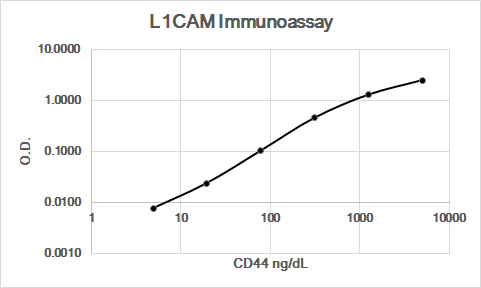Human L1CAM Antibody Summary
Ile20-Glu1120
Accession # CAA42508
Applications
Please Note: Optimal dilutions should be determined by each laboratory for each application. General Protocols are available in the Technical Information section on our website.
Scientific Data
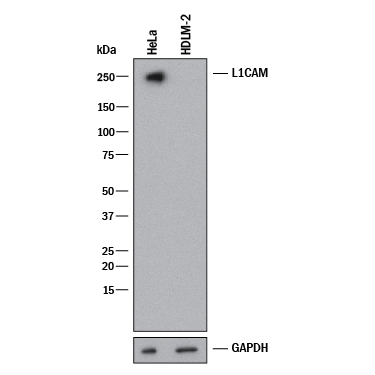 View Larger
View Larger
Detection of Human L1CAM by Western Blot. Western blot shows lysates of HeLa human cervical epithelial carcinoma cell line and HDLM‑2 human Hodgkin’s lymphoma cell line (negative control). PVDF membrane was probed with 0.25 µg/mL of Goat Anti-Human L1CAM Antigen Affinity-purified Polyclonal Antibody (Catalog # AF277) followed by HRP-conjugated Anti-Goat IgG Secondary Antibody (HAF017). A specific band was detected for L1CAM at approximately 250 kDa (as indicated). GAPDH (AF5718) is shown as a loading control. This experiment was conducted under reducing conditions and using Western Blot Buffer Group 1.
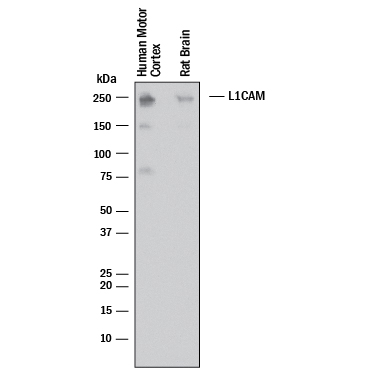 View Larger
View Larger
Detection of Human and rat L1CAM by Western Blot. Western blot shows lysates of human brain (motor cortex) and rat brain. PVDF membrane was probed with 0.5 µg/mL of Goat Anti-Human L1CAM Antigen Affinity-purified Polyclonal Antibody (Catalog # AF277) followed by HRP-conjugated Anti-Goat IgG Secondary Antibody (HAF017). A specific band was detected for L1CAM at approximately 240 kDa (as indicated). This experiment was conducted under reducing conditions and using Western Blot Buffer Group 1.
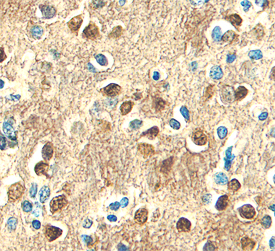 View Larger
View Larger
L1CAM in Human Brain. L1CAM was detected in immersion fixed paraffin-embedded sections of human brain (hippocampus) using Goat Anti-Human L1CAM Antigen Affinity-purified Poly-clonal Antibody (Catalog # AF277) at 10 µg/mL overnight at 4 °C. Before incubation with the primary antibody, tissue was subjected to heat-induced epitope retrieval using Antigen Retrieval Reagent-Basic (Catalog # CTS013). Tissue was stained using the Anti-Goat HRP-DAB Cell & Tissue Staining Kit (brown; Catalog # CTS008) and counter-stained with hematoxylin (blue). Specific staining was localized to plasma membranes and cytoplasm of neurons. View our protocol for Chromogenic IHC Staining of Paraffin-embedded Tissue Sections.
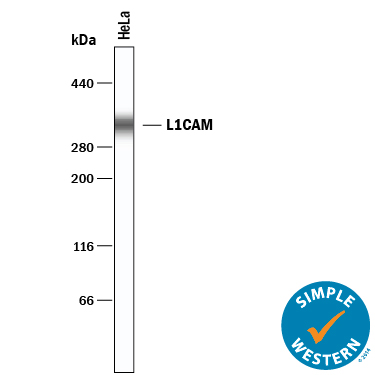 View Larger
View Larger
Detection of Human L1CAM by Simple WesternTM. Simple Western lane view shows lysates of HeLa human cervical epithelial carcinoma cell line, loaded at 0.2 mg/mL. A specific band was detected for L1CAM at approximately 333 kDa (as indicated) using 5 µg/mL of Goat Anti-Human L1CAM Antigen Affinity-purified Polyclonal Antibody (Catalog # AF277). This experiment was conducted under reducing conditions and using the 66-440 kDa separation system.
Reconstitution Calculator
Preparation and Storage
- 12 months from date of receipt, -20 to -70 °C as supplied.
- 1 month, 2 to 8 °C under sterile conditions after reconstitution.
- 6 months, -20 to -70 °C under sterile conditions after reconstitution.
Background: L1CAM
L1CAM (Neural cell adhesion molecule L1, also known as L1, CD171 and NCAM-L1) is a 200-230 kDa member of the L1 family, Immunoglobulin (Ig) superfamily of molecules. L1 is recognized to play a key role in cell migration, adhesion, neurite outgrowth, myelination and neuronal differentiation. It does so through a series of cis and trans interactions that involve multiple copartners and target receptors. L1 is described as forming both homotypic and heterotypic complexes, the latter with molecules as diverse as the EGFR, NCAM, CD24, neurocan and various alpha v plus beta 1 and beta 3 integrins. Cells known to express L1 include immature oligodendrocytes, CD4+ T cells, B cells and monocytes, premyelinating Schwann cells, intestinal epithelial progenitor cells, and cerebellar granule plus Purkinje cells. Mature human L1 is a 1238 amino acid (aa) type I transmembrane protein. It contains an 1101 aa extracellular region (aa 20-1120) plus a 114 aa cytoplasmic domain (aa 1144-1257). The extracellular region possesses six C2-type Ig-like domains (aa 35-607) followed by five fibronectin (FN) type III repeats (aa 612-1108). The cytoplasmic tail contains no kinase motifs, but does possess a FIGQY peptide that interacts with ankyrin, and an RSLE sequence that mediates clathrin-associated endocytosis. At least five Ser residues are known to be phosphorylated. There are two splice variants, one each in the intracellular and extracellular domain. A deletion of RSLE (aa 1177-1180) adversely affects endocytosis, while a Leu substitution for aa 26-31 interfers with numerous heterotypic interactions. In general, the full-length L1 molecule is a neuron-associated isoform. L1 is known to undergo proteolysis, either by plasmin or ADAMs. This generates soluble isoforms of varying sizes (140-200 kDa) that retain bioactivity, and which can be incorporated into the surrounding ECM. The membrane fragments (30-80 kDa) undergo further processing, most importantly by gamma ‑secretase, to generate a soluble 28 kDa intracellular domain. This domain is SUMOylated, and believed to possess an NLS at Lys1147. Upon presumed entry into the nucleus, L1 is posited to activate L1-responsive genes. In the extracellular region, human and mouse L1 share 86% aa sequence identity.
Product Datasheets
Citations for Human L1CAM Antibody
R&D Systems personnel manually curate a database that contains references using R&D Systems products. The data collected includes not only links to publications in PubMed, but also provides information about sample types, species, and experimental conditions.
2
Citations: Showing 1 - 2
Filter your results:
Filter by:
-
Secretome and degradome profiling shows that Kallikrein-related peptidases 4, 5, 6, and 7 induce TGFbeta-1 signaling in ovarian cancer cells.
Authors: Shahinian H, Loessner D, Biniossek M, Kizhakkedathu J, Clements J, Magdolen V, Schilling O
Mol Oncol, 2013-10-01;8(1):68-82.
Species: Human, Mouse
Sample Types: Cell Culture Supernates, Whole Tissue
Applications: IHC, Western Blot -
The L1 cell adhesion molecule is a potential biomarker of human distal nephron injury in acute tubular necrosis.
Authors: Allory Y, Audard V, Fontanges P, Ronco P, Debiec H
Kidney Int., 2007-12-05;73(6):751-8.
Species: Human
Sample Types: Urine
Applications: ELISA Development
FAQs
No product specific FAQs exist for this product, however you may
View all Antibody FAQsReviews for Human L1CAM Antibody
Average Rating: 5 (Based on 1 Review)
Have you used Human L1CAM Antibody?
Submit a review and receive an Amazon gift card.
$25/€18/£15/$25CAN/¥75 Yuan/¥2500 Yen for a review with an image
$10/€7/£6/$10 CAD/¥70 Yuan/¥1110 Yen for a review without an image
Filter by:
